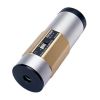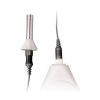Extech 407780A Integrating Sound Level Datalogger
Features
- Precise linearity over wide range (100dB)
- Data logging function can record up to 32,000 records
- Programmable integrating time
- Free ground shipping
- Expedited repair and warranty service
- Lifetime technical support
- More
Overview
The Extech Integrating Sound Level Meter takes Leq and SEL measurements with a built-in data logger and PC interface.
Benefits
- 4-digit multifunction LCD with analog bar graph
- Precise linearity over a wide range (100dB)
- Display modes: SPL, SPL MIN/MAX, SEL, and Leq
- Programmable integrating time
- A and C Frequency weighting
- Impulse/Fast/Slow response settings
- Datalogging function records up to 32,000 records
- Real-time calendar/clock
- Analog and alarm output features can be used to connect with Frequency analyzers, chart recorders, external dataloggers, and sound level alarms
- Built-in USB interface with included Windows® datalogging software
- Tripod mount
- Meets IEC 61672-1, 60651/60804 Type 2 and ANSI S1.4 Type 2 specifications
- Complete with windscreen, adjustment screwdriver, USB cable, Windows® compatible software, battery, and case
- (1) Sound level meter
- (1) USB cable
- (1) Windows compatible software
- (1) Windscreen
- (4) AA batteries
- (1) Carrying case
In The News
Monitoring and Facilitating Habitat Restoration Efforts in the Great Lakes
While human infrastructure, urbanization, and industrialization have advanced human societies, the natural environment has suffered due to constructed impediments and deteriorating architecture. In order to combat this degradation, habitat restoration programs across the US work to remove impairments and improve damaged waterways. [caption id="attachment_39162" align="aligncenter" width="940"] Barge electrofishing by state and federal employees prior to habitat restoration on Wiscoy Creek which is a tributary to the Genesee River. (Credit Thomas Hoffman)[/caption] Habitat Restoration Efforts in the Great Lakes Tom Hoffman, aquatic habitat restoration biologist in the Lower Great Lakes basin, directs restoration efforts within tributaries to Lake Erie, Lake Ontario, and the St.
Read MoreSustainable Fishing in Alaska: Protecting the Salmon Capital of the World through Research
In the far north, the Alaska Peninsula stretches away from the Last Frontier into the Pacific Ocean. A narrow strip of land dotted with freshwater lakes and intruded upon by ocean inlets–this unique region is intimately connected with the surrounding water. Nestled halfway down the peninsula's southern coast are the small villages of Chignik. The area has historically been home to the Aleut people and has been heavily reliant on fishing for centuries. Home to commercial and subsistence fishing today, Chignik continues to rely upon the salmon returns to the surrounding villages, which are supported by scientists working tirelessly to understand and steward these fish populations.
Read MoreNexSens X3 Data Logger Review
Extreme environments meet extreme design with the NexSens X3 Data Logger . The new logger offers the latest in real-time monitoring technology with wireless communication, a large plug-and-play sensor library and ultra-low power consumption, all in a waterproof marine-grade housing. The X3 is built to handle harsh weather, floods, high winds and rough seas, and it stands alone; no additional protective housing needed. With an operating temperature that ranges from -40°C to 70°C, the logger can withstand arctic environments and extreme heat. A conformal coating on the internal circuit board isolates it from moisture and humidity.
Read More













